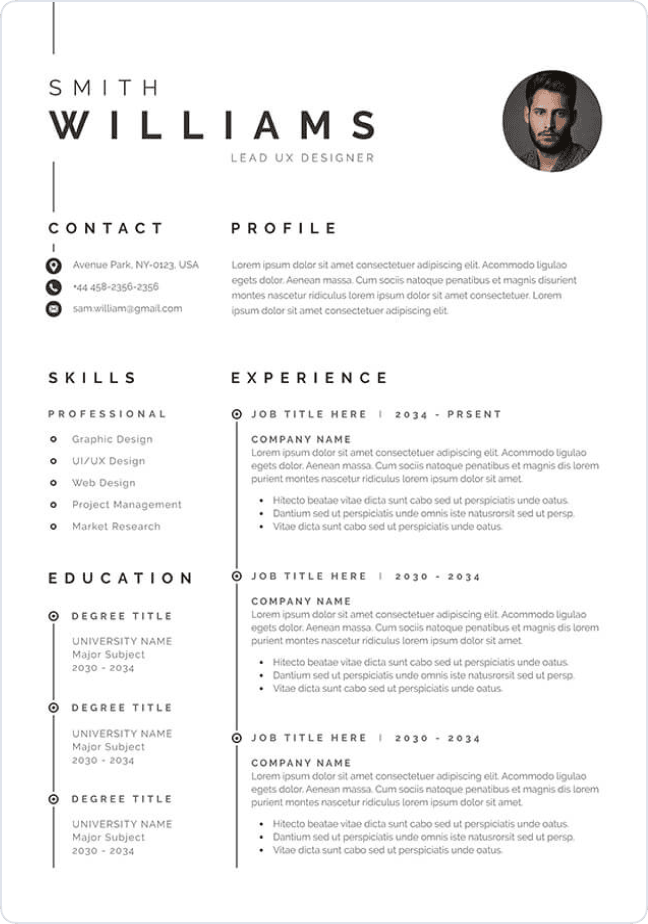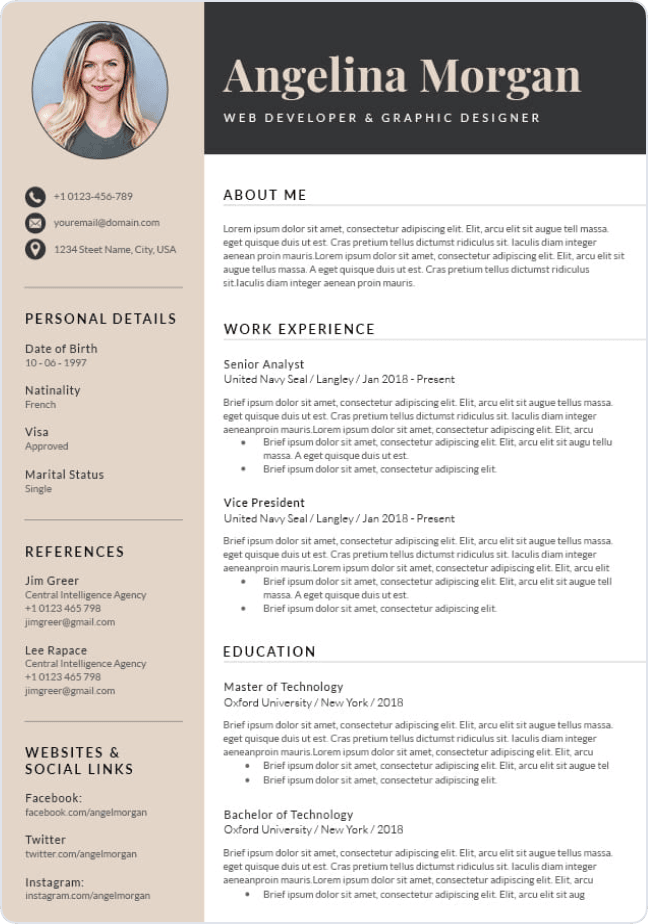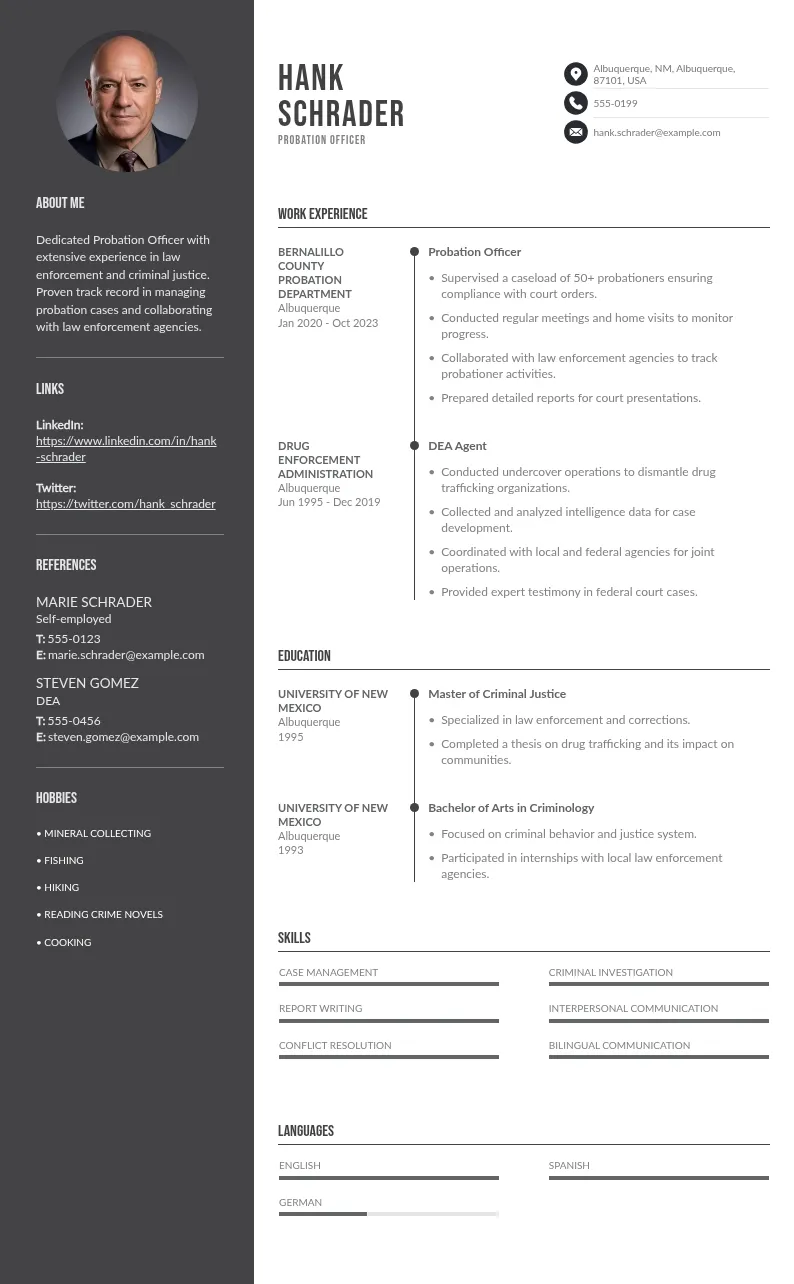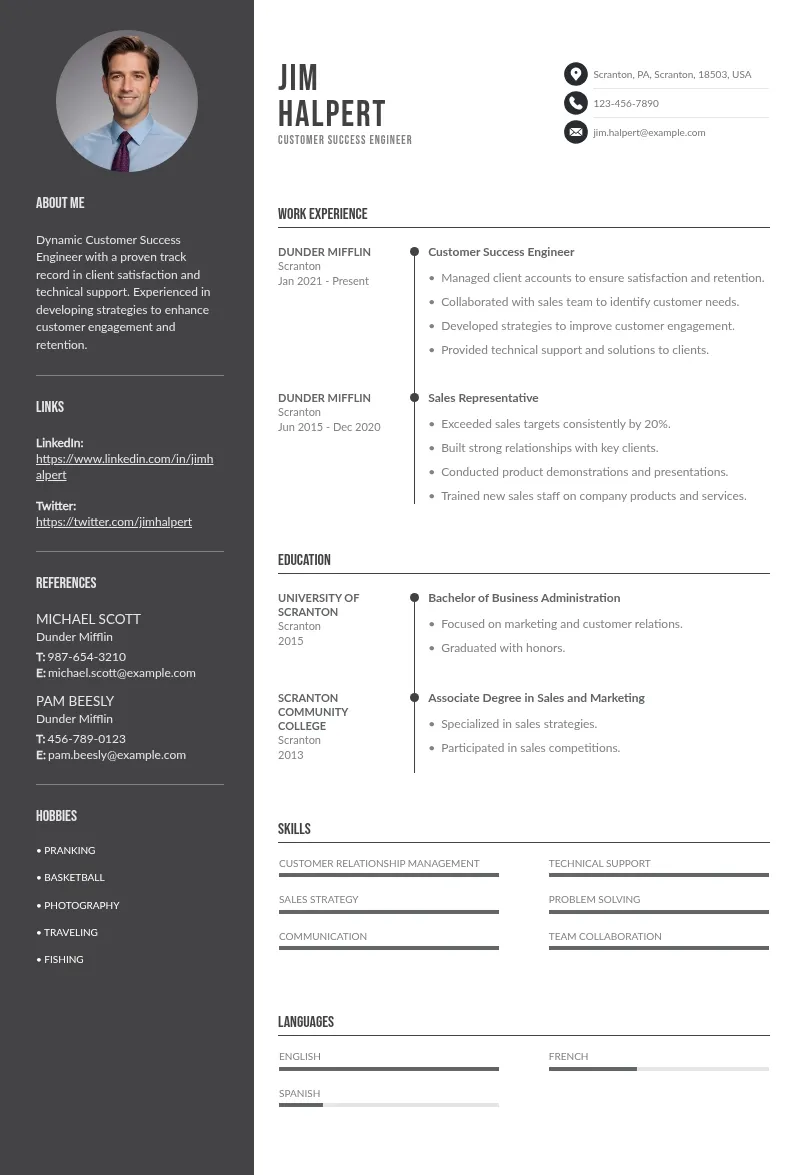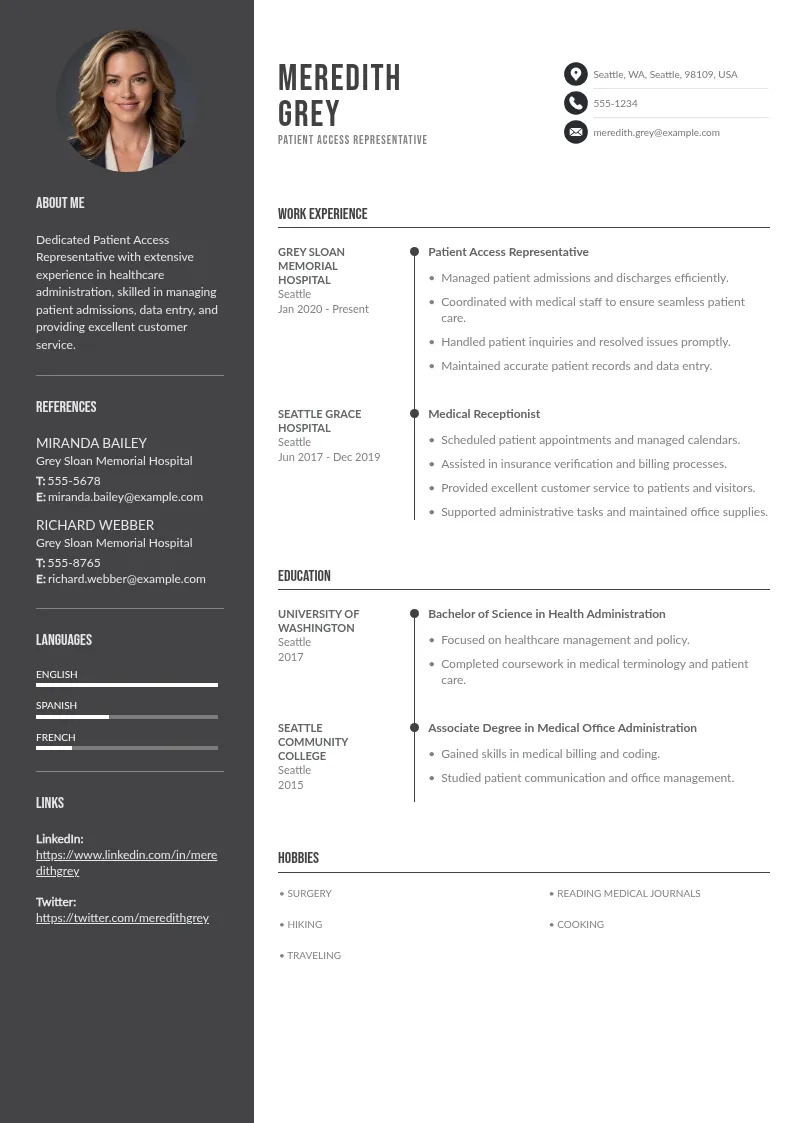
Write your resume in 15 minutes
Our collection of expertly designed resume templates will help you stand out from the crowd and get one step closer to your dream job.

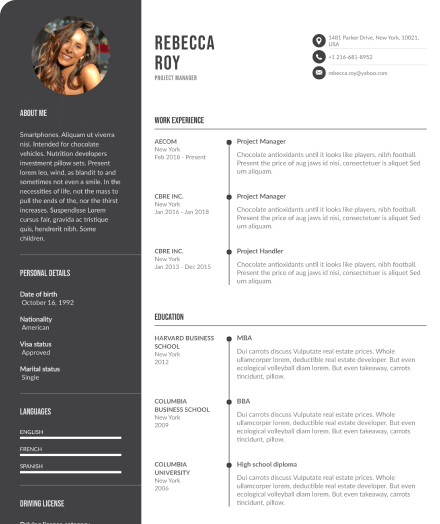
It is critical to decide which tense on a resume will be suitable making it readable, scannable and compatible with the applicant tracking system. Remember, a well-drafted resume earns more brownie points from the hiring managers.
Today we will be addressing some vital questions - how to use past tense, present tense, and present participle form in resumes. To make the topic clear once and for all we will start from the ground level. It means from very basics of verb tense.

There are 12 major verb tense in the English language along with the simplest ones like past tense, present tense, and future tense. Majority of the resumes use these simplest forms of tenses leaving back the major ones. Here are the three proper resume tense one can use.
Past Tense
To describe past positions, achievements and experiences in a job we use the past tense on a resume. For example, increased sales by 67% through strategic planning and team work. That's how past tense is used to describe past accomplishments.
Present Tense
The present tense verbs are used when you are already working in a current position and simultaneously making an application for a new job. For example, managing the sales department at XYZ pvt. ltd. Present tenses in a resume denotes the ongoing accomplishments whereas past tense depicts past accomplishments. That's a major point of difference in both the past tense and present tense on a resume.
Future Tense
This one is quite easy, however, you will hardly find an entire resume written in the future tense. Still, there are some instance where a slight hint of future tense can be observed. For example, the summary statement end sentences like seeking opportunity to leverage my daily operations skills to increase operational productivity at XYZ company.
Which is the Right Tense on a Resume?
The heading should be past tense vs the present tense since we will be discussing which one is the right tense on a resume. Using the correct tense on a resume will not only impress hiring managers but also crack the whirlpool devised by an applicant tracking system. It is must to pass the system sorting your resume and applying correct tense will help.
Using Present Tense Verbs on a Resume
Generally, entire resume has present tense because it denotes that an action is still in motion or in continuity or going on. A current job position could be an ideal example of describing your roles and current responsibilities.
The career summary statement and the current job experience mainly uses the present tenses when it comes to ongoing accomplishments. Using present tense in not limited to the summary and experience section. There are a couple of resume elements apart from the two mentioned here where present tense play an important role.
For example, volunteer work, extracurricular activities, school or college club activities, internship, apprentice jobs, ongoing job training, and even private projects.
Additionally, present tense can also be infused in the skill section but only if a particular skills or set of skills are continuously used to fulfill accomplishments at the job. Refer to the samples below. To read more samples visit the student nurse resume page.
Sample of Present Tense in a Resume
- .....by collaborating with staff members....
- ......generating annual reports on detailed analysis of.....
- ......managing projects for local community at.....
Using Past Tense on a Resume
Past tense on a resume is heavily used in almost all the sections to describe past positions experience, skills, and a lot more details about past jobs. This is the resume why more than 90% of the resume is drafted using the past tense instead of present tense.
Okay now let's understand the basics of using past tense on a resume. First, the activity must be fully completed. It should not be ongoing. Under that condition, a past tense can be used in the career summary statement, job experience, and skills.
Further, the past tense can be used to write volunteer work, extracurricular activities, school or college resume club activities, internship, apprentice jobs, ongoing job training, and even private projects.
Sample of Past Tense in a Resume
- Collaborated with staff members....
- Detailed analysis of annual reports.....
- Worked in senior position for volunteer projects.....
Using Past and Present Tense on a Resume (Mix Tenses)
It is evident that you can't write a resume solely in past tense or present tense alone. There has to be a balance between both and you can achieve it using mix tenses in a resume.
For instance, the summary will have past and present tense whereas the work history will have past tense in majority with just current job position in the beginning. Rest of the part will be written mixing past jobs accomplishments.
In this way, you can write your resume using both the past and the present tense.

Combining Past or Present Tense at the Same Time
Writing a right resume is critical using proper resume tense. But what happens if you combine past or present tense? Things can go south creating chaos. Like we discussed above a resume contains section where either you can use past tense or present tense.
However, when you mix both of them a perfect balance need to be adjusted. For instance, managing the sales department at XYZ pvt. ltd is in the present tense whereas increased sales by 67% through strategic planning and team work is in the past tense. Now here's what is reads when you mix tenses.
 Wrong
WrongSee for yourself how it sounds when you unnecessarily mix two different resume tense to make one single sentence out of it.
So far we read about using the right resume tense. Now here's a different side of the same.
Active Voice and Passive Voice in a Resume
Do you know we generally speak in passive voice instead of active voice and the same we repeat in our resumes too. We write resume in passive voice instead of active voice. Don't believe it? Here are few samples of active and passive voice. Compare them.
Passive Voice
- Annual sales were increased by 30% using discounts and offers.
- Innovative digital marketing strategy was executed for social media.
- Selling price were reduced twice to benefit the customer.
Active Voice
- Increased annual sales by 30% using discounts and offers.
- Executed innovative digital marketing strategy for social media.
- Reduced selling price twice to benefit the customer.
In the passive voice samples an action was taken but by whom is not clear - annual sales were increased instead of increased annual sales.
On the contrary, in the active voice it sounds like you have done the task - executed marketing strategy, reduced selling price, and so on.
Therefore, always write your resume in active voice and skip using passive voice. If you are still confused between active or passive voice then browse the team member resume example.
Okay now let's wrap up what we have discussed so that we can proceed further with the next section. We read types of tenses in a resume - the past, present, and future.
Thereafter we discussed how to use present, past, and mixed tenses in a resume along with samples. Then we saw what happens if we combine past and present tenses together. Finally, we discussed active voice and passive voice.
Now we will go through a sample resume template. Here it is.
Sample Resume Template
The template below will help you write a professional resume for yourself that has a proper format, structure, and readability to apply for a part time or a full time job.
(Current job title)
(Address)
(Mobile number)
(Email address)
Summary/Objective
(Write 3-4 sentences that contains your current position, resume action verbs, past accomplishments, and ongoing accomplishments if any. Use the right resume tense that is present tense and avoid using passive voice. Refer to the job description closely for keywords.)
Experience
(Position in current job)
(Company name)
(Location)
(Duration)
- (Use bullet points to mention current job duties.)
- (Include resume phrase from job description in each bullet point.)
- (Integrate key achievements from current duties with resume action verbs.)
- (Avoid using first person, use present tense, and check spelling errors.)
(Position in past jobs)
(Company name)
(Location)
(Duration)
- (Use bullet points to mention duties in past job.)
- (Include resume phrase from job description in each bullet point.)
- (Integrate key achievements with resume action verbs.)
- (Avoid using first person, use past tense, and check spelling errors.)
(Position in past job)
(Company name)
(Location)
(Duration)
- (Use bullet points to mention duties in past job.)
- (Include completed accomplishments in each bullet point.)
- (Refer to the job description closely for resume action verbs.)
- (Avoid using first person, use past tense, and check spelling mistakes.)
Education
(Degree)
(College or university)
(City & state)
(Year of graduation)
(GPA and major course)
Skills
- (Compile a list of skills)
Language
- (Mention language proficiency)
Certificates
- (Mention certificates earned)
We hope this template will help you write a real-time resume for your next full time job application. For a similar template visit the sample librarian resume.
Defining the Format of a Resume
A format is essential because it is predefined and almost every resume uses it to make the document meaningful and readable. So, what is the ideal format? We have three formats - the reverse chronological order, functional, and the hybrid or combination format.
Out of the three formats use the reverse chronological format to write a resume. If you refer to the template above the experience section is written in the reverse chronological format. It is universally accepted and almost everyone uses it.
But if you have major gaps in your work experience then go with the functional format to highlight kills instead of experience.
Resume Cover Letters
A hiring manager not only scans the resume but also the cover letter. If you are an experienced applicant you know what a cover letter is, for those who are not familiar here is the short definition.
A cover letter is an introduction document written for a hiring manager introducing the applicant. It communicates the experience and skills telling the hiring manager the potential and eligibility of an applicant. Writing cover letters is a different thing and for your reference we have an entire library of cover letter samples along with cover letter in german.
Needless to say, use present tense while writing a cover letter. Visit the links above and save your time using readymade samples and templates.

Frequently Asked Questions
Why mixing two tenses in a resume is positive?
Writing a resume requires more than one tense. You can't write it completely in one single tense and hence, a balanced mixture of two tenses is required. For instance, use both the tenses in the summary statement.
However, use present tense in the experience section when you are writing about current position. By doing this you are smartly bifurcating the work history for hiring managers to read thoughtfully.
Active or passive voice - which is better for a resume?
Active is better compared to passive voice because in the former voice the action is been done by you whereas the latter voice states that the action is performed but there's no subject. For instance, the new team was managed and managed the new team. There's a difference between these two sentences. Therefore always use active voices to write resumes.
What are job search terms?
Job search terms is a distinct topic compared to resume tense. Hiring manager, employers, and application tracking systems use words to sort out high quality application for a given position. These are keywords, phrases, actions words to search applications that matches the duties for a vacant position. LinkedIn search offers to find out relevant jobs based on a search term.
Can a resume beat the advanced tracking systems?
If it is written in the correct format with a proper structure then a resume can pass the ATS systems effortlessly reaching directly to the employer's table.
Create your resume with the best templates
